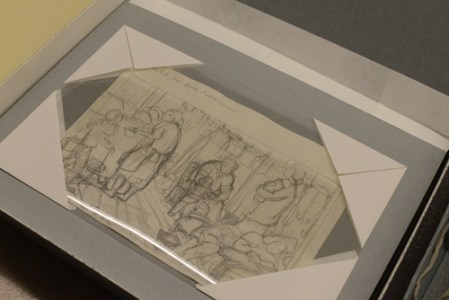
Giant Robot Biennale 4 is a highly interactive show, with several features that invite viewer engagement on a more active level than usual. One of these features is the live, on-site creation of a major new work by Katsuya Terada.
Starting shortly before the exhibition opened in October, Terada spent several days working inside of a roped-off area in JANM’s lower-level galleries to create a new, two-part drawing from scratch. Visitors were able to watch him as he worked. The artist had to leave town before he could finish, but he plans to return later this month (after the 19th) to complete the piece in the gallery.

Photo by Carol Cheh.
The live drawing idea came from Eric Nakamura, curator of the show and founder of the Giant Robot empire. “Museums are typically filled with static objects,” he noted. “I wanted to present an interactive experience, where people could ask questions, and see what artists are like in person. It’s not everywhere that you can do this.” Nakamura gave Teraya no time limits, wanting him to produce a finished work that is suitable for framing.
So far the work is looking exquisitely finished right out of the gate. It does not yet have a title, but it does have a theme: masks. “I thought it would be interesting to draw a mask wearing a mask,” the artist says. Terada, who speaks very little English, spoke to me shortly before he left with the help of his friend and fellow exhibiting artist Yoskay Yamamoto, who served as translator.
I asked Terada to explain his process, which is organic rather than planned. “If I draw one line, that will tell me how to draw the next line,” he replied. “However, when I see the entire surface, and I start drawing one image, that will usually be the starting point, and from there I’m just trying to fill up the page without making mistakes—in composition, in choice of items to draw. I’m just making sure everything fits in the right way.”

Personally, I would find that process stressful. I asked him how he felt about that, and about having people watch him while he draws.
“It is stressful! But it’s like I’m challenging myself by being in that position,” Terada replied. “Having an audience can be a positive thing—it means that I have to work hard and I can’t slack off. But drawing itself is just enjoyable to me, with or without an audience.”
Terada will be back at JANM sometime after December 19th to complete his drawing. Keep your eyes on JANM’s Twitter feed and Facebook page to see when he’s in the gallery. Until then, you can come to the museum to view his progress to date.

JANM later this month to complete the work. Photo by Carol Cheh.

![Estelle Ishigo (Gift of Mary Ruth Blackburn, Japanese American National Museum [2000.103.12])](https://i0.wp.com/media.discovernikkei.org/articles/4279/ishigo2.jpg?resize=269%2C215)


